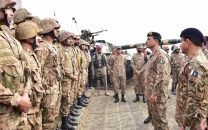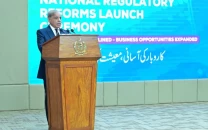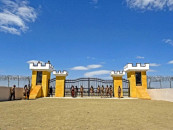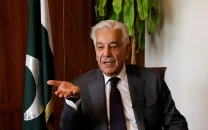Obama was ‘50-50’ certain about OBL’s presence in Abbottabad
‘A Promised Land’ sheds light on how raid was planned, executed

In his latest book, former US president Barack Obama provides an in-depth first-hand look into how the 2011 raid on Osama bin Laden’s Abbottabad compound was planned and carried out.
In what is arguably the most eye-opening section of ‘A Promised Land’, Obama recounts how he and his administration were aware of the seismic implications the move carried for US-Pakistan’s already strained ties. The chapter also reveals that the former president and his team had only been ’50-50’ certain that their target was actually bin Laden when the raid was ordered.
“Whatever option we chose could not involve the Pakistanis,” Obama writes. “Whatever we chose to do in Abbottabad… would involve violating the territory of a putative ally in the most egregious way possible, short of war.”
Even so, the former president admits that his upcoming bid for re-election played heavily into his decision to authorise the strike. “I had to decide whether or not to authorise a raid deep inside Pakistan to go after a target we believed to be Osama bin Laden—and whatever else happened, I was likely to end up a one-term president if I got it wrong.”
According to Obama, he was presented with two options once they had a strong suspicion of bin Laden’s presence in Abbottabad. “The first was to demolish it [bin Laden’s compound] with an air strike,” he reveals, stating that the benefits of that approach were ‘obvious’. “No American lives would be risked on Pakistani soil… the Pakistanis would… know that we were the ones who’d carried out the strike, but they would have an easier time maintaining the fiction that we might not be, which could help quell outrage among their people.”
However, the former president says he was ultimately swayed by the ‘significant downsides’ of a missile strike. “If we destroyed the compound, how would we ever be certain that bin Laden had been there? If al Qaeda denied that bin Laden had been killed, how would we explain having blown up a residence deep inside Pakistan?”
A special ops mission was the second option tabled before Obama, he writes. “Guided by data collected by aerial photography, the CIA had built a small three-dimensional replica of the Abbottabad compound,” he recounts, adding that the then chief of US Special Operations Command Bill McRaven walked him through how a raid might go.
“Getting out… might be a little more ‘sporty’,” Obama recalls being told by McRaven. “What would we do if Pakistani fighters intercepted our helicopters, either on the way in or on the way out? What if bin Laden was on-site but hidden or in a safe room, thus extending the amount of time the special ops team spent on the ground? How would the team respond if Pakistani police or military forces surrounded the compound during the raid?”
According to Obama, the planning was built on the premise that US troops should avoid a firefight with Pakistani authorities. “If the authorities confronted us on the ground, his [McRaven’s] inclination would be to have the SEALs hold in place while our diplomats tried to negotiate a safe exit.”
But with US-Pakistan relations in a particularly precarious state and rising anti-American sentiment due to drone strikes and the Raymond Davis episode, Obama and his defence aide express serious reservations.
“I was not going to risk putting the fate of our SEALs in the hands of a Pakistani government that would no doubt face intense public pressure over whether to jail or release them—especially if it turned out that bin Laden wasn’t in the compound,” the former president writes.
According to Obama, when he and his team conducted a final review of their options for the Abbottabad operation, they concluded it was a ’50-50 call’. “[CIA Director] Leon Panetta, [Homeland Security Adviser] John Brennan, and [Chairman of Joint Chiefs of Staff] Mike Mullen favored the raid,” he recalls. “Hillary said that for her, it was a 51–49 call, carefully ticking through the risks of a raid—especially the danger that we could rupture our relations with Pakistan, or even find ourselves in a confrontation with the Pakistani military.”
Even Obama’s vice president, current US President Elect Joe Biden was against the raid due to “the enormous consequences of failure.” But the decision to go ahead with the strike was ultimately informed by constraints over maintaining secrecy.
With plan set in motion, Obama recounts how he had a virtual birds eye view of the raid from the Situation Room in the White House. “I was given updates on plans for notifying Pakistan and other countries and our diplomatic strategies in the event of either success or failure,” he writes. “If bin Laden was killed in the raid, preparations had been made for a traditional Islamic burial to take place at sea, avoiding the creation of a pilgrimage site for jihadists.”
“The team had planned for us to follow the operation indirectly… [but] I had noticed that a live aerial view of the compound, as well as McRaven’s voice, was being transmitted to a video monitor in a smaller conference room across the hall,” he adds. “As the helicopters drew close to the target, I stood up from my seat. ‘I need to watch this’… This was the first and only time as president that I’d watch a military operation unfold in real time.”
When one of the modified Black Hawk choppers made a bumpy landing at the Abbottabad compound, Obama writes he felt ‘an electric kind of fear’. “A disaster reel played in my head—a chopper crashing, the SEALs scrambling to get out before the machine caught fire, a neighborhood of people emerging from their homes to see what happened as the Pakistani military rushed to the scene.”
“McRaven’s voice interrupted my nightmare. “It’ll be fine,” he said,” the ex-president added.
According to Obama, he could only make out grainy figures on the ground for much of the duration of the raid. “For twenty excruciating minutes, even McRaven had a limited view of what was taking place,” he writes. “Then, with a suddenness I didn’t expect, we heard McRaven’s and Leon’s voices, almost simultaneously, utter the words we’d been waiting to hear… “Geronimo ID’d…Geronimo EKIA.” Enemy killed in action. Osama bin Laden—code-named “Geronimo” for the purposes of the mission — had been brought to justice.”
Following the operation, Obama recalls discussing the possibility of holding off on an official announcement. “But reports of a helicopter crash in Abbottabad were already starting to pop up on the internet.” And when Mike Mullen called then Pakistan Army chief Ashfaq Parvez Kayani, the latter requested the US come clean ‘as quickly as possible’.
Obama also writes that he expected his most difficult call would be with his Pakistani counterpart Asif Zardari. “When I reached him, however, he expressed congratulations and support. ‘Whatever the fallout,’ he said, ‘it’s very good news’.”


















COMMENTS
Comments are moderated and generally will be posted if they are on-topic and not abusive.
For more information, please see our Comments FAQ